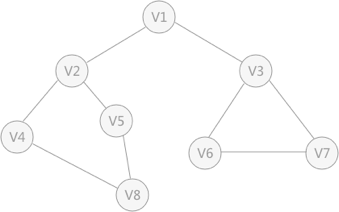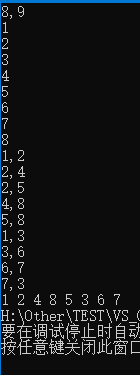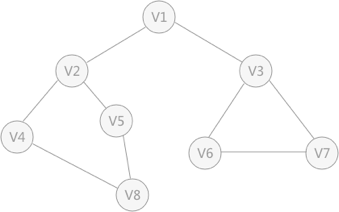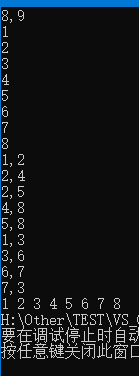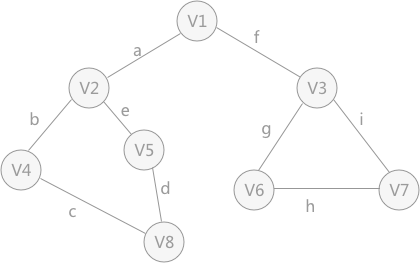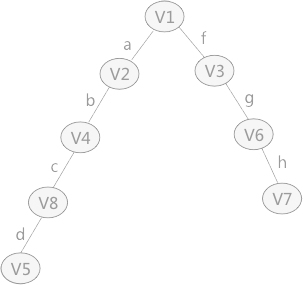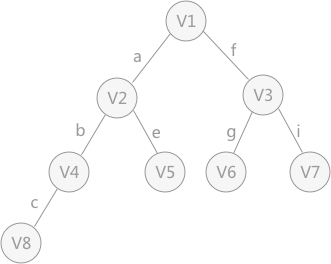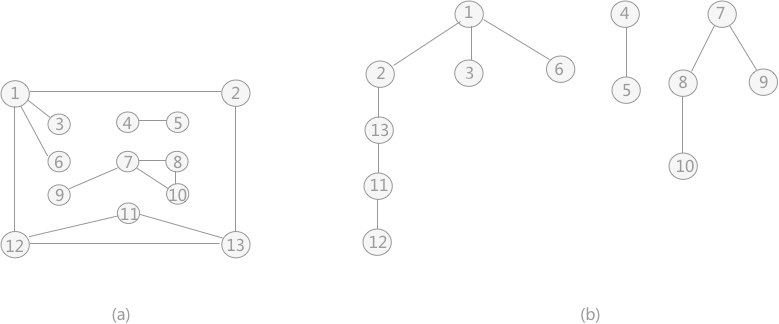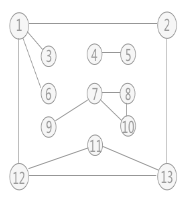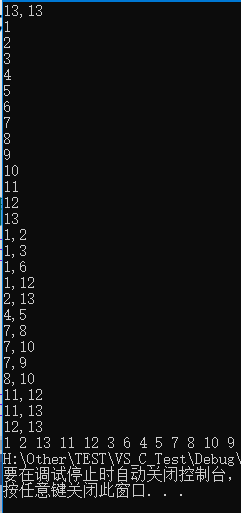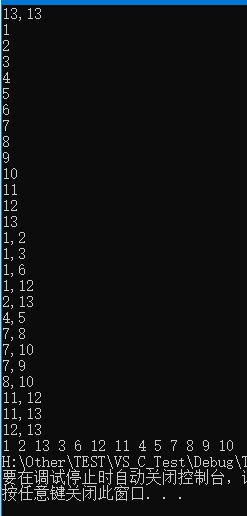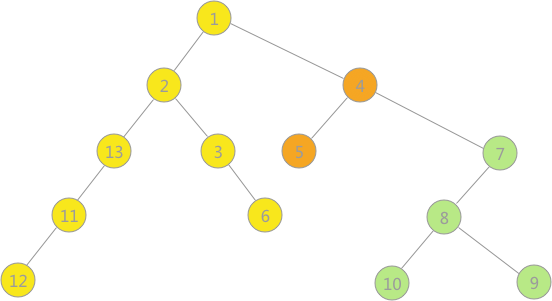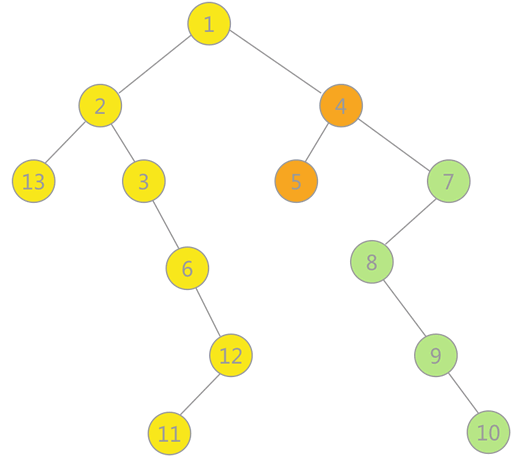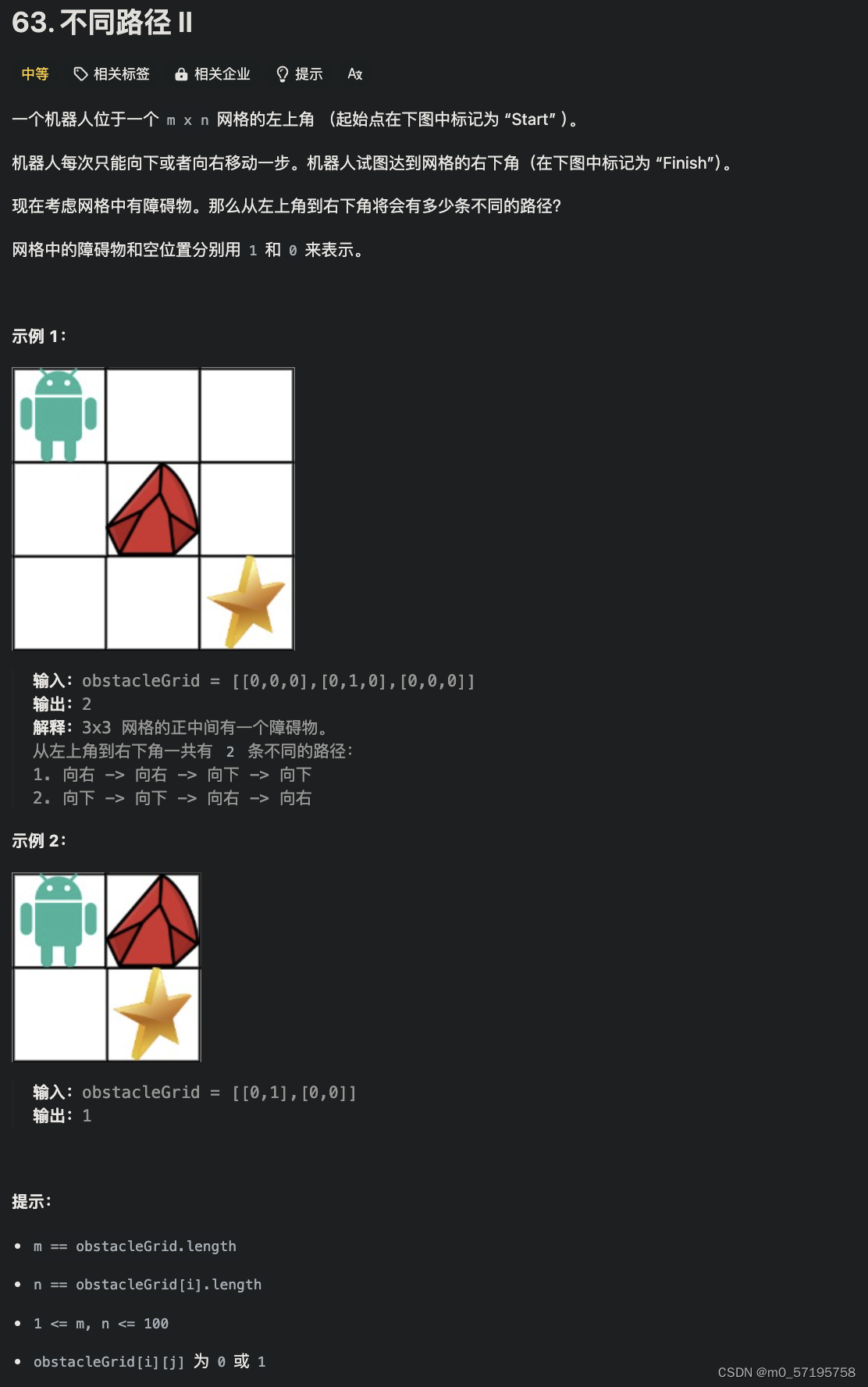对存储的图中的顶点进行遍历搜索,常用的遍历方式有两种:深度优先 搜索和广度优先 搜索。 深度优先 搜索 】 深度优先 搜索的过程 类似于树的先序遍历 ,首先从例子中体会深度优先 搜索。例如下图是一个无向图,采用深度优先 算法遍历这个图的过程为: 首先任意找一个未被遍历过的顶点,例如从 V1 开始,由于 V1 率先访问过了,所以,需要标记 V1 的状态为访问过; 然后遍历 V1 的邻接点,例如访问 V2 ,并做标记,然后访问 V2 的邻接点,例如 V4 (做标记),然后 V8 ,然后 V5 ; 当继续遍历 V5 的邻接点时,根据之前做的标记显示,所有V5 的邻接点都被访问过了。此时,从 V5 回退到 V8 ,看 V8 是否有未被访问过的邻接点,如果没有,继续回退到 V4 , V2 ,V1 ; 通过查看 V1 ,找到一个未被访问过的顶点 V3 ,继续遍历,然后访问 V3 邻接点 V6 ,然后 V7 ; 由于 V7 没有未被访问的邻接点,所以回退到 V6 ,继续回退至 V3 ,最后到达 V1 ,发现没有未被访问的; 最后一步需要判断是否所有顶点都被访问,如果还有没被访问的,以未被访问的顶点为第一个顶点,继续依照上边的方式进行遍历。 根据上边的过程,可以得到下图通过深度优先 搜索获得的顶点的遍历次序为: 总结:深度优先 搜索深度优先 搜索是一个不断回溯的过程),查看来的路上每一个顶点是否有其它未被访问的临接点。访问完成后,判断图中的顶点是否已经全部遍历完成,如果没有,以未访问的顶点为起始点,重复上述过程。 # define _CRT_SECURE_NO_WARNINGS 1 # include <stdio.h> # define MAX_VERtEX_NUM 20 # define VertexType int # define VRType int # define InfoType char bool visited[ MAX_VERtEX_NUM] ;
typedef struct { VRType adj; InfoType* info;
} ArcCell, AdjMatrix[ MAX_VERtEX_NUM] [ MAX_VERtEX_NUM] ;
typedef struct { VertexType vexs[ MAX_VERtEX_NUM] ; AdjMatrix arcs; int vexnum, arcnum;
} MGraph;
int LocateVex ( MGraph* G, VertexType v) { int i = 0 ; for ( ; i < G-> vexnum; i++ ) { if ( G-> vexs[ i] == v) { break ; } } if ( i > G-> vexnum) { printf ( "no such vertex.\n" ) ; return - 1 ; } return i;
}
void CreateDN ( MGraph* G) { scanf ( "%d,%d" , & ( G-> vexnum) , & ( G-> arcnum) ) ; for ( int i = 0 ; i < G-> vexnum; i++ ) { scanf ( "%d" , & ( G-> vexs[ i] ) ) ; } for ( int i = 0 ; i < G-> vexnum; i++ ) { for ( int j = 0 ; j < G-> vexnum; j++ ) { G-> arcs[ i] [ j] . adj = 0 ; G-> arcs[ i] [ j] . info = NULL ; } } for ( int i = 0 ; i < G-> arcnum; i++ ) { int v1, v2; scanf ( "%d,%d" , & v1, & v2) ; int n = LocateVex ( G, v1) ; int m = LocateVex ( G, v2) ; if ( m == - 1 || n == - 1 ) { printf ( "no this vertex\n" ) ; return ; } G-> arcs[ n] [ m] . adj = 1 ; G-> arcs[ m] [ n] . adj = 1 ; }
}
int FirstAdjVex ( MGraph G, int v)
{ for ( int i = 0 ; i < G. vexnum; i++ ) { if ( G. arcs[ v] [ i] . adj) { return i; } } return - 1 ;
}
int NextAdjVex ( MGraph G, int v, int w)
{ for ( int i = w + 1 ; i < G. vexnum; i++ ) { if ( G. arcs[ v] [ i] . adj) { return i; } } return - 1 ;
}
void visitVex ( MGraph G, int v) { printf ( "%d " , G. vexs[ v] ) ;
}
void DFS ( MGraph G, int v) { visited[ v] = true ; visitVex ( G, v) ; for ( int w = FirstAdjVex ( G, v) ; w >= 0 ; w = NextAdjVex ( G, v, w) ) { if ( ! visited[ w] ) { DFS ( G, w) ; } }
}
void DFSTraverse ( MGraph G)
{ int v; for ( v = 0 ; v < G. vexnum; ++ v) { visited[ v] = false ; } for ( v = 0 ; v < G. vexnum; v++ ) { if ( ! visited[ v] ) { DFS ( G, v) ; } }
} int main ( ) { MGraph G; CreateDN ( & G) ; DFSTraverse ( G) ; return 0 ;
}
使用上述程序存储下图的无向图时,输入如下数据,得到DFS的输出结果:
8 , 9
1
2
3
4
5
6
7
8
1 , 2
2 , 4
2 , 5
4 , 8
5 , 8
1 , 3
3 , 6
6 , 7
7 , 3
广度优先 搜索 】 广度优先 搜索 类似于树的层次遍历 。以下图的无向图为例,假设 V1 作为起始点,遍历其所有的邻接点 V2 和 V3 ,以 V2 为起始点,访问邻接点 V4 和 V5 ,以 V3 为起始点,访问邻接点 V6 、 V7 ,以 V4 为起始点访问 V8 ,以 V5 为起始点,由于 V5 所有的起始点已经全部被访问,所有直接略过, V6 和 V7 也是如此。总结:广度优先 搜索 # define _CRT_SECURE_NO_WARNINGS 1 # include <stdio.h> # include <stdlib.h> # define MAX_VERtEX_NUM 20 # define VertexType int # define VRType int # define InfoType char bool visited[ MAX_VERtEX_NUM] ;
typedef struct Queue { VertexType data; struct Queue * next;
} Queue;
typedef struct { VRType adj; InfoType* info;
} ArcCell, AdjMatrix[ MAX_VERtEX_NUM] [ MAX_VERtEX_NUM] ;
typedef struct { VertexType vexs[ MAX_VERtEX_NUM] ; AdjMatrix arcs; int vexnum, arcnum;
} MGraph;
int LocateVex ( MGraph* G, VertexType v) { int i = 0 ; for ( ; i < G-> vexnum; i++ ) { if ( G-> vexs[ i] == v) { break ; } } if ( i > G-> vexnum) { printf ( "no such vertex.\n" ) ; return - 1 ; } return i;
}
void CreateDN ( MGraph* G) { scanf ( "%d,%d" , & ( G-> vexnum) , & ( G-> arcnum) ) ; for ( int i = 0 ; i < G-> vexnum; i++ ) { scanf ( "%d" , & ( G-> vexs[ i] ) ) ; } for ( int i = 0 ; i < G-> vexnum; i++ ) { for ( int j = 0 ; j < G-> vexnum; j++ ) { G-> arcs[ i] [ j] . adj = 0 ; G-> arcs[ i] [ j] . info = NULL ; } } for ( int i = 0 ; i < G-> arcnum; i++ ) { int v1, v2; scanf ( "%d,%d" , & v1, & v2) ; int n = LocateVex ( G, v1) ; int m = LocateVex ( G, v2) ; if ( m == - 1 || n == - 1 ) { printf ( "no this vertex\n" ) ; return ; } G-> arcs[ n] [ m] . adj = 1 ; G-> arcs[ m] [ n] . adj = 1 ; }
}
int FirstAdjVex ( MGraph G, int v)
{ for ( int i = 0 ; i < G. vexnum; i++ ) { if ( G. arcs[ v] [ i] . adj) { return i; } } return - 1 ;
}
int NextAdjVex ( MGraph G, int v, int w)
{ for ( int i = w + 1 ; i < G. vexnum; i++ ) { if ( G. arcs[ v] [ i] . adj) { return i; } } return - 1 ;
}
void visitVex ( MGraph G, int v) { printf ( "%d " , G. vexs[ v] ) ;
}
void InitQueue ( Queue* * Q) { ( * Q) = ( Queue* ) malloc ( sizeof ( Queue) ) ; ( * Q) -> next = NULL ;
}
void EnQueue ( Queue* * Q, VertexType v) { Queue* element = ( Queue* ) malloc ( sizeof ( Queue) ) ; element-> data = v; element-> next = NULL ; Queue* temp = ( * Q) ; while ( temp-> next != NULL ) { temp = temp-> next; } temp-> next = element;
}
void DeQueue ( Queue* * Q, int * u) { ( * u) = ( * Q) -> next-> data; ( * Q) -> next = ( * Q) -> next-> next;
}
bool QueueEmpty ( Queue* Q) { if ( Q-> next == NULL ) { return true ; } return false ;
}
void BFSTraverse ( MGraph G) { int v; for ( v = 0 ; v < G. vexnum; ++ v) { visited[ v] = false ; } Queue* Q; InitQueue ( & Q) ; for ( v = 0 ; v < G. vexnum; v++ ) { if ( ! visited[ v] ) { visited[ v] = true ; visitVex ( G, v) ; EnQueue ( & Q, G. vexs[ v] ) ; while ( ! QueueEmpty ( Q) ) { int u; DeQueue ( & Q, & u) ; u = LocateVex ( & G, u) ; for ( int w = FirstAdjVex ( G, u) ; w >= 0 ; w = NextAdjVex ( G, u, w) ) { if ( ! visited[ w] ) { visited[ w] = true ; visitVex ( G, w) ; EnQueue ( & Q, G. vexs[ w] ) ; } } } } }
} int main ( ) { MGraph G; CreateDN ( & G) ; BFSTraverse ( G) ; return 0 ;
}
使用上述程序存储下图的无向图时,输入如下数据,得到DFS的输出结果:
8 , 9
1
2
3
4
5
6
7
8
1 , 2
2 , 4
2 , 5
4 , 8
5 , 8
1 , 3
3 , 6
6 , 7
7 , 3
无向图遍历过程中所经历过的图中的顶点和边的组合,就是图的生成树或者生成森林。 由深度优先 搜索得到的树为 深度优先 生成树深度优先 搜索算法时,假设 V1 作为遍历的起始点,涉及到的顶点和边的遍历顺序为(不唯一): 同理,广度优先 搜索生成的树为 广度优先 生成树广度优先 搜索遍历得到的树,如下图所示: 前言回顾:详情见:【C 数据结构 】图。 对下图 a 的非连通图采用深度优先 搜索算法遍历时,得到的深度优先 生成森林(由 3 个深度优先 生成树构成)如下图 b 所示(不唯一)。
# define _CRT_SECURE_NO_WARNINGS 1 # include <stdio.h> # include <stdlib.h> # define MAX_VERtEX_NUM 20 # define VertexType int # define VRType int bool visited[ MAX_VERtEX_NUM] ;
typedef struct
{ VRType adj;
} ArcCell, AdjMatrix[ MAX_VERtEX_NUM] [ MAX_VERtEX_NUM] ;
typedef struct { VertexType vexs[ MAX_VERtEX_NUM] ; AdjMatrix arcs; int vexnum, arcnum;
} MGraph;
typedef struct CSNode { VertexType data; struct CSNode * lchild; struct CSNode * nextsibling;
} * CSTree, CSNode;
int LocateVex ( MGraph G, VertexType v) { int i = 0 ; for ( ; i < G. vexnum; i++ ) { if ( G. vexs[ i] == v) { break ; } } if ( i > G. vexnum) { printf ( "no such vertex.\n" ) ; return - 1 ; } return i;
}
void CreateDN ( MGraph* G) { scanf ( "%d,%d" , & ( G-> vexnum) , & ( G-> arcnum) ) ; getchar ( ) ; for ( int i = 0 ; i < G-> vexnum; i++ ) { scanf ( "%d" , & ( G-> vexs[ i] ) ) ; } for ( int i = 0 ; i < G-> vexnum; i++ ) { for ( int j = 0 ; j < G-> vexnum; j++ ) { G-> arcs[ i] [ j] . adj = 0 ; } } for ( int i = 0 ; i < G-> arcnum; i++ ) { int v1, v2; scanf ( "%d,%d" , & v1, & v2) ; int n = LocateVex ( * G, v1) ; int m = LocateVex ( * G, v2) ; if ( m == - 1 || n == - 1 ) { printf ( "no this vertex\n" ) ; return ; } G-> arcs[ n] [ m] . adj = 1 ; G-> arcs[ m] [ n] . adj = 1 ; }
}
int FirstAdjVex ( MGraph G, int v)
{ for ( int i = 0 ; i < G. vexnum; i++ ) { if ( G. arcs[ v] [ i] . adj) { return i; } } return - 1 ;
}
int NextAdjVex ( MGraph G, int v, int w)
{ for ( int i = w + 1 ; i < G. vexnum; i++ ) { if ( G. arcs[ v] [ i] . adj) { return i; } } return - 1 ;
} void DFSTree ( MGraph G, int v, CSTree* T) { visited[ v] = true ; bool first = true ; CSTree q = NULL ; for ( int w = FirstAdjVex ( G, v) ; w >= 0 ; w = NextAdjVex ( G, v, w) ) { if ( ! visited[ w] ) { CSTree p = ( CSTree) malloc ( sizeof ( CSNode) ) ; p-> data = G. vexs[ w] ; p-> lchild = NULL ; p-> nextsibling = NULL ; if ( first) { ( * T) -> lchild = p; first = false ; } else { q-> nextsibling = p; } q = p; DFSTree ( G, w, & q) ; } }
}
void DFSForest ( MGraph G, CSTree* T) { ( * T) = NULL ; for ( int v = 0 ; v < G. vexnum; v++ ) { visited[ v] = false ; } CSTree q = NULL ; for ( int v = 0 ; v < G. vexnum; v++ ) { if ( ! ( visited[ v] ) ) { CSTree p = ( CSTree) malloc ( sizeof ( CSNode) ) ; p-> data = G. vexs[ v] ; p-> lchild = NULL ; p-> nextsibling = NULL ; if ( ! ( * T) ) { ( * T) = p; } else { q-> nextsibling = p; } q = p; DFSTree ( G, v, & p) ; } }
}
void PreOrderTraverse ( CSTree T) { if ( T) { printf ( "%d " , T-> data) ; PreOrderTraverse ( T-> lchild) ; PreOrderTraverse ( T-> nextsibling) ; } return ;
} int main ( ) { MGraph G; CreateDN ( & G) ; CSTree T; DFSForest ( G, & T) ; PreOrderTraverse ( T) ; return 0 ;
}
使用上述程序存储下图的无向图,输入如下数据,构建深度优先 生成森林,得到DFS的输出结果: 构建的深度优先 生成森林用孩子兄弟表示法如下所示:3 种颜色的树各代表一棵深度优先 生成树,使用孩子兄弟表示法表示,也就是将三棵树的树根相连,第一棵树的树根作为整棵树的树根。
13 , 13
1
2
3
4
5
6
7
8
9
10
11
12
13
1 , 2
1 , 3
1 , 6
1 , 12
2 , 13
4 , 5
7 , 8
7 , 10
7 , 9
8 , 10
11 , 12
11 , 13
12 , 13
非连通图采用广度优先 搜索算法进行遍历时,经过的顶点以及边的集合为该图的 广度优先 生成森林 C 实现: # include <stdio.h> # include <stdlib.h> # define MAX_VERtEX_NUM 20 # define VRType int # define InfoType char # define VertexType int typedef enum { false , true } bool ;
bool visited[ MAX_VERtEX_NUM] ;
typedef struct { VRType adj; InfoType * info;
} ArcCell, AdjMatrix[ MAX_VERtEX_NUM] [ MAX_VERtEX_NUM] ; typedef struct { VertexType vexs[ MAX_VERtEX_NUM] ; AdjMatrix arcs; int vexnum, arcnum;
} MGraph; typedef struct CSNode { VertexType data; struct CSNode * lchild; struct CSNode * nextsibling;
} * CSTree, CSNode; typedef struct Queue { CSTree data; struct Queue * next;
} Queue;
int LocateVex ( MGraph * G, VertexType v) { int i= 0 ; for ( ; i< G-> vexnum; i++ ) { if ( G-> vexs[ i] == v) { break ; } } if ( i> G-> vexnum) { printf ( "no such vertex.\n" ) ; return - 1 ; } return i;
}
void CreateDN ( MGraph * G) { scanf ( "%d,%d" , & ( G-> vexnum) , & ( G-> arcnum) ) ; for ( int i= 0 ; i< G-> vexnum; i++ ) { scanf ( "%d" , & ( G-> vexs[ i] ) ) ; } for ( int i= 0 ; i< G-> vexnum; i++ ) { for ( int j= 0 ; j< G-> vexnum; j++ ) { G-> arcs[ i] [ j] . adj= 0 ; G-> arcs[ i] [ j] . info= NULL ; } } for ( int i= 0 ; i< G-> arcnum; i++ ) { int v1, v2; scanf ( "%d,%d" , & v1, & v2) ; int n= LocateVex ( G, v1) ; int m= LocateVex ( G, v2) ; if ( m== - 1 || n== - 1 ) { printf ( "no this vertex\n" ) ; return ; } G-> arcs[ n] [ m] . adj= 1 ; G-> arcs[ m] [ n] . adj= 1 ; }
} int FirstAdjVex ( MGraph G, int v)
{ for ( int i = 0 ; i< G. vexnum; i++ ) { if ( G. arcs[ v] [ i] . adj ) { return i; } } return - 1 ;
}
int NextAdjVex ( MGraph G, int v, int w)
{ for ( int i = w+ 1 ; i< G. vexnum; i++ ) { if ( G. arcs[ v] [ i] . adj) { return i; } } return - 1 ;
}
void InitQueue ( Queue * * Q) { ( * Q) = ( Queue* ) malloc ( sizeof ( Queue) ) ; ( * Q) -> next= NULL ;
}
void EnQueue ( Queue * * Q, CSTree T) { Queue * element= ( Queue* ) malloc ( sizeof ( Queue) ) ; element-> data= T; element-> next= NULL ; Queue * temp= ( * Q) ; while ( temp-> next!= NULL ) { temp= temp-> next; } temp-> next= element;
}
void DeQueue ( Queue * * Q, CSTree * u) { ( * u) = ( * Q) -> next-> data; ( * Q) -> next= ( * Q) -> next-> next;
}
bool QueueEmpty ( Queue * Q) { if ( Q-> next== NULL ) { return true ; } return false ;
} void BFSTree ( MGraph G, int v, CSTree* T) { CSTree q= NULL ; Queue * Q; InitQueue ( & Q) ; EnQueue ( & Q, ( * T) ) ; while ( ! QueueEmpty ( Q) ) { bool first= true ; DeQueue ( & Q, & q) ; int v= LocateVex ( & G, q-> data) ; visited[ v] = true ; for ( int w= FirstAdjVex ( G, v) ; w>= 0 ; w= NextAdjVex ( G, v, w) ) { if ( ! visited[ w] ) { CSTree p= ( CSTree) malloc ( sizeof ( CSNode) ) ; p-> data= G. vexs[ w] ; p-> lchild= NULL ; p-> nextsibling= NULL ; EnQueue ( & Q, p) ; visited[ w] = true ; if ( first) { q-> lchild= p; first= false ; } else { q-> nextsibling= p; } q= p; } } }
}
void BFSForest ( MGraph G, CSTree * T) { ( * T) = NULL ; for ( int v= 0 ; v< G. vexnum; v++ ) { visited[ v] = false ; } CSTree q= NULL ; for ( int v= 0 ; v< G. vexnum; v++ ) { if ( ! ( visited[ v] ) ) { CSTree p= ( CSTree) malloc ( sizeof ( CSNode) ) ; p-> data= G. vexs[ v] ; p-> lchild= NULL ; p-> nextsibling= NULL ; if ( ! ( * T) ) { ( * T) = p; } else { q-> nextsibling= p; } q= p; BFSTree ( G, v, & p) ; } }
}
void PreOrderTraverse ( CSTree T) { if ( T) { printf ( "%d " , T-> data) ; PreOrderTraverse ( T-> lchild) ; PreOrderTraverse ( T-> nextsibling) ; } return ;
}
int main ( ) { MGraph G; CreateDN ( & G) ; CSTree T; BFSForest ( G, & T) ; PreOrderTraverse ( T) ; return 0 ;
}
使用上述程序存储下图的无向图,输入如下数据,构建广度优先 生成森林,得到BFS的输出结果:
13 , 13
1
2
3
4
5
6
7
8
9
10
11
12
13
1 , 2
1 , 3
1 , 6
1 , 12
2 , 13
4 , 5
7 , 8
7 , 10
7 , 9
8 , 10
11 , 12
11 , 13
12 , 13

